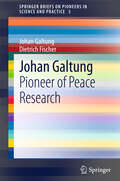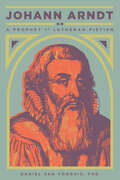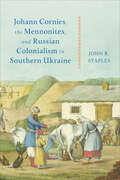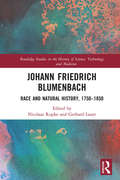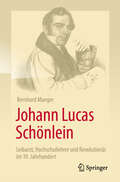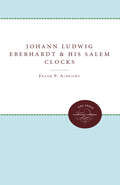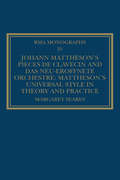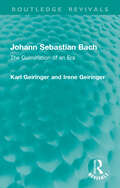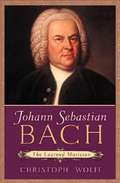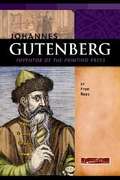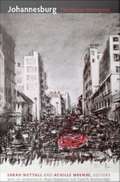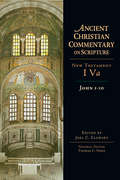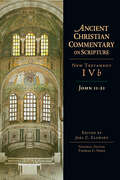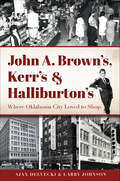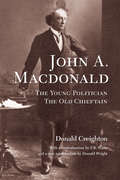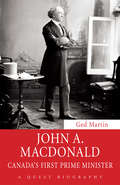- Table View
- List View
Johan Galtung
by Dietrich Fischer Johan GaltungThis is the first ever anthology of key articles by Johan Galtung, widely regarded as the founder of the academic discipline of peace studies. It covers such concepts as direct, structural and cultural violence; theories of conflict, development, civilization and peace; peaceful conflict transformation; peace education; mediation; reconciliation; a life-sustaining economy; macro-history; deep culture and deep structure; and social science methodology. Galtung has contributed original research, concepts and theories to more than 20 social science disciplines, including sociology, international relations and future studies, and has also applied his new insights in practice. The book is a valuable resource for researchers and practitioners, and can serve as a supplemental textbook for graduate and upper undergraduate courses in peace studies and related fields.
Johann Arndt: A Prophet of Lutheran Pietism
by Daniel Van VoorhisThis is the story of the most significant devotional author of the seventeenth century in his first full English language biography. Using previously unknown letters as a few of the resources, this story aims to recreate the theological, sometimes magical, and social worlds of Johann Arndt. Arndt was regarded by his peers and successive generations as either the most significant Reformer since Luther, or an uneducated and dangerous element within the Lutheran church. Later commentators have given Arndt the credit, or blame, for the founding of the Pietist movement. Arndt was a central figure in the forging of various Lutheran "orthodoxies" of the early seventeenth century and thus the first generation to attempt an interpretation of the Lutheran Confessions of Faith. He is challenged by some on the conservative right for his mystical influences, but was a hero to orthodox Lutheran Johann Gerhard. He did more than found the pietist tradition (which he actually may or may not have); he also became the father of a Lutheran spiritual, maybe mystical tradition. While this movement would only last in more extreme forms of the Lutheran church, the argument from Arndt, Gerhard, and others was that this tradition was not in conflict with the teachings of the Lutheran Confessions. It's a movement that almost was, and lives on in whispers in the church today.
Johann Cornies, the Mennonites, and Russian Colonialism in Southern Ukraine (Tsarist and Soviet Mennonite Studies)
by John R. StaplesIn the late eighteenth century, the Russian Empire opened the grasslands of southern Ukraine to agricultural settlement by new colonists, among them Prussian Mennonites. Mennonite colonization was one aspect of the empire’s consolidation and modernization of its multi-ethnic territory. In the colony of Molochnaia, the dominant personality of the early nineteenth century was Johann Cornies (1789–1848), a hard-driving modernizer and intimate of senior Russian officials whose papers provide unique access into events in Ukraine in this era. Johann Cornies, the Mennonites, and Russian Colonialism in Southern Ukraine uses the life story of Johann Cornies to explore how colonial subjects interacted with Russian imperial policy. The book reveals how tsarist imperial policy shifted toward Russification in the 1830s and 1840s and became increasingly intolerant of ethnocultural and ethnoreligious minorities. It shows that Russia employed the Mennonite settlement as a colonial laboratory of modernity, and that the Mennonites were among Russia’s most economically productive subjects. This microhistory illuminates the role of Johann Cornies as a mediator between the empire and the Mennonite colonists, and it ultimately aims to bring light to the history of nineteenth-century Russia and Ukraine.
Johann Friedrich Blumenbach: Race and Natural History, 1750–1850 (Routledge Studies in the History of Science, Technology and Medicine)
by Nicolaas Rupke Gerhard LauerThe major significance of the German naturalist-physician Johann Friedrich Blumenbach (1752–1840) as a topic of historical study is the fact that he was one of the first anthropologists to investigate humankind as part of natural history. Moreover, Blumenbach was, and continues to be, a central figure in debates about race and racism. How exactly did Blumenbach define race and races? What were his scientific criteria? And which cultural values did he bring to bear on his scheme? Little historical work has been done on Blumenbach’s fundamental, influential race work. From his own time till today, several different pronouncements have been made by either followers or opponents, some accusing Blumenbach of being the fountainhead of scientific racism. By contrast, across early nineteenth-century Europe, not least in France, Blumenbach was lionized as an anti-racist whose work supported the unity of humankind and the abolition of slavery. This collection of essays considers how, with Blumenbach and those around him, the study of natural history and, by extension, that of science came to dominate the Western discourse of race.
Johann Gottlieb Fichte: Ein deutscher Philosoph in europäischer Umbruchszeit
by Gerd IrrlitzFichte ist – trotz fabelhafter Gesamtausgabe – der am meisten interpretationsbedürftige Kopf der nachkantischen Philosophie. Sein Werk bildet für unsere Zeit den interessantesten Teil der sogenannten klassischen deutschen Philosophie von Kant zu Fichte, Schelling und Hegel. Gerd Irrlitz sieht das Rebellierende – und manchmal auch Geblendete – eines großen deutschen Reformdenkers, der national dachte, weil der Absolutismus die Internationalität war, und weil er eine antifeudale Bewegung des Volkes beobachtete, die ihm aufgrund der Schwäche des deutschen Absolutismus und durch die antinapoleonische Bewegung der „Freiheitskriege“ möglich erschien. Die neuzeitliche europäische Philosophie war plötzlich mit dem Ton der Empörung und dem Anspruch des einfachen Volkes konfrontiert. Beides mündete nach dem Erfolg des antinapoleonischen Feldzugs in die Verfassungsbewegung. Dieses Buch behandelt nach einem einführenden Überblick und einer ausführlichen Biographie alle Themenbereiche der Philosophie Fichtes: die Wissenschaftslehre, die Philosophie des Rechts, der Moral und der Religion (die 1799 zur Entlassung an der Jenaer Universität führte), die Sozialreform, die beiden frühen Schriften zur Französischen Revolution und die nationale Thematik in den „Reden an die deutsche Nation“ (1808).
Johann Gutenberg: the Inventor of Printing
by Victor ScholdererThis short book draws on legal documents surviving from the 15th century, in an attempt to piece together information about the life of the inventor of the printing press. When all is said and done, however, very little can actually be known about Gutenberg's life.
Johann Lucas Schönlein - Leibarzt, Hochschullehrer und Revolutionär im 19. Jahrhundert
by Bernhard MangerDieses Buch schildert in einer schlanken Ausgabe die Lebensgeschichte von Johann Lucas Schönlein und verknüpft diese gekonnt mit politischen Ereignissen des 19. Jahrhundert. Schönlein war u.a. Leibarzt des preußischen Königs, befreundet mit Alexander von Humboldt und unterrichtete an der Berliner Charité. Er hat jedoch auch den Beginn der deutschen Demokratie und deren Folgen von damaligen Unruhen live miterlebt – und war davon betroffen. Zitate aus einem Fund von über 1000 medizinischen, institutionellen und privaten Briefen Schönleins begleiten den Text und geben einen privaten Einblick in historische Ereignisse der Medizingeschichte und Politik: Lernen Sie eine facettenreiche und einflussreiche Persönlichkeit kennen, die die moderne Medizin entscheidend mitprägte und erfahren Sie nebenbei mehr über die politischen Ereignisse des 19. Jahrhunderts hautnah mit. So spannend können die Entwicklung der Medizin und Geschichte sein
Johann Ludwig Eberhardt and His Salem Clocks (Old Salem Series)
by Frank P. AlbrightEberhardt (1758-1839) was master clockmaker in Salem for more than thirty-eight years. Albright attributes more than thirty clocks to Eberhardt, building his evidence by a diligent reading of the Moravian records and by a careful cataloging of the characteristics of each clock. He reconstructs Eberhardt's methods of clockmaking in precise detail from the inventories and the purchase invoices of equipment and materials, and he attempts to identify the cabinetmaker in each case.Originally published in 1978.A UNC Press Enduring Edition -- UNC Press Enduring Editions use the latest in digital technology to make available again books from our distinguished backlist that were previously out of print. These editions are published unaltered from the original, and are presented in affordable paperback formats, bringing readers both historical and cultural value.
Johann Mattheson's Pièces de clavecin and Das neu-eröffnete Orchestre: Mattheson's Universal Style in Theory and Practice
by Margaret SearesA prolific music theorist and critic as well as an established composer, Johannes Mattheson remains surprisingly understudied. In this important study, Margaret Seares places Mattheson‘s Pi‘s de clavecin (1714) in the context of his work as a public intellectual who encouraged German musicians and their musical public to eschew what he saw as the hidebound traditions of the past, and instead embrace a universalism of style and expression derived from contemporary currents in music of the leading European nations. Beginning with the early non-musical writings by Mattheson, Seares places them in the context of the cosmopolitan city-state of Hamburg, before moving to a detailed study of his first major musical treatise Das neu-er ffnete Orchestre of 1713, in which he espoused his views about the musics of the past and present and, in particular, the characteristics of the musics of Germany, Italy, France and England. This latter section of the treatise, Part III, is edited and translated into English in the book's appendix - the first such translation available. Seares then moves on to an evaluation of the Pi‘s de clavecin as a work in which Mattheson reflects in musical terms the themes of modernism (in the sense ofa mode) and universalism that are such a strong part of his writings of the period, and a work that represents an important precursor for the keyboard suites of Johann Sebastian Bach and Georg Frideric Handel.
Johann Sebastian Bach: Life and Work
by Martin Geck John HargravesGeck (musicology, Dortmund U., Germany) provides a study of Johann Sebastian Bach's life and music. He traces the career path the composer followed, from his early education to role as Kapellmeister of the St. Thomas Church in Leipzig and director of the collegium musicum. He then reserves half of the volume for an examination of Bach's music by genre, analyzing individual pieces and groups of vocal and instrumental works, and ends with brief discussions of specific topics such as Bach as a Christian, rhetoric and symbolism, proportion and numerical relations in his music, and theological research. The book has been translated from the German version by Hargraves (German language and literature, Yale U. and Connecticut College). Annotation ©2007 Book News, Inc., Portland, OR (booknews.com)
Johann Sebastian Bach: The Culmination of an Era (Routledge Revivals)
by Karl Geiringer Irene GeiringerWhen it was originally published in 1967, this study of J.S. Bach was the first important work on the composer in nearly a generation. The many discoveries about Bach’s life and music that occurred in the postwar years created the need for a new interpretative study incorporating this research and this was the only book which incorporated the vast amount of material uncovered since 1950, the bicentennial of Bach’s death. The volume begins with a brief biography and is followed by an analysis of each major type of composition: vocal, organ, keyboard and instrumental music. In each section the author examines thoroughly many Bach compositions and evaluates them in relation to the rest of the composer’s work, as well as in relation to the music of his contemporaries. More than 70 music examples enable the reader to understand how Bach worked, the manner in which his genius developed and grew, and to see outstanding excerpts from his music in various stages of completion. An interesting aspect of research methods is revealed through an explanation of the detective work which has been done regarding handwriting, paper and watermarks in the original sources.
Johann Sebastian Bach: The Learned Musician
by Christoph WolffPublished on the 250th anniversary of the composer's death, this life history portrays Bach as the human being that he was, while bringing to bear all the advances gained in the last half-century of Bach scholarship. Wolff (professor of music, and dean of the Graduate School of Arts and Sciences, Harvard U.) demonstrates the intimate connection between the composer's life and his music, showing how Bach's superb inventiveness pervaded his career as musician, composer, performer, scholar, and teacher. He also provides a look at Bach's life and his surroundings, as well as how he fit into the broader context of the institutions, traditions, and influences of his time. Annotation c. Book News, Inc., Portland, OR (booknews.com)
Johann Sleidan and the Protestant Vision of History (St Andrews Studies in Reformation History)
by Alexandra KessOne of the major challenges faced by the emergent Protestant faith was how to establish itself in a hitherto Catholic world. A key way it found to achieve this was to create a common identity through the fashioning of history, emphasising Protestantism's legitimacy and authority. In this study, the life and works of one of the earliest and most influential Protestant historians, Johann Sleidan (1506-1556) are explored to reveal how history could be used to consolidate the new confession and the states which adopted it. Sleidan was commissioned by leading intellectuals from the Schmalkadic League to write the official history of the German Protestant movement, resulting in the publication in 1555 of De statu religionis et reipublicae, Carolo Quinto, Caesare, Commentarii. Overnight his work became the standard account of the early Reformation, referenced by Catholics and Protestants alike in subsequent histories and polemical debates for the next three centuries. Providing the first comprehensive account of Sleidan's life, based almost entirely on primary sources, this book offers a convincing background and context for his writings. It also shows how Sleidan's political role as a diplomat impacted on his work as a historian, and how in turn his monumental work influenced political debate in France and Germany. As a moderate who sought to promote accommodation between the rival confessions, Sleidan provides a fascinating subject of study for modern historians seeking to better understand the complex and multi-faceted nature of the early Reformation.
Johannes Gutenberg: Inventor Of The Printing Press (Signature Lives Series)
by Fran Rees Frank Romano Rosemary G. PalmerA biography profiling the life of Johannes Gutenberg, a man from the Renaissance era who is best known for developing the printing press that took the place of the time-consuming method of copying books by hand. <P><P>Gutenberg's greatest accomplishment was the printing of a Latin Bible -- the Gutenberg Bible, as it came to be known. His name became forever linked to this magnificent masterpiece and to the printing press that transformed the world.
Johannes Vermeer: Getting to Know the World's Greatest Artists
by Mike VeneziaA biography of Johannes Vermeer. An overview of the life and work of the seventeenth-century Dutch painter, famous for creating realistic scenes of everyday life.
Johannes von Kries: A Logical Investigation (Studies in History and Philosophy of Science #59)
by Keith K. NiallThis book provides an English translation of the work Principles of the Probability Calculus published in 1886 by Johannes von Kries, which discusses the range theory of probability. It offers a novel account of the foundations of probability, an account which was familiar to Keynes, Kneale, Weber, Reichenbach, and von Mises. This account dispenses with the principle of indifference in probability, and it introduces the method of arbitrary functions. Confusions in the history of probability are pinpointed, and a novel theory is developed in which probability is neither entirely subjective nor objective. The book develops what is known as the range theory or Spielraum theory in detail, in a narrative way using few formulas. Von Kries applies range theory to Boltzmann’s theory of the statistical behaviour of gases, and to several applications in medical statistics. Many uses of probability are found wanting; very often they are found not to admit any expression of probability in numbers at all. The book will be of first interest to philosophers of science and historians interested in the foundations of probability. It is also of general interest to anyone who applies statistics everyday in such fields as econometrics, psychology, or medicine.
Johannesburg: The Elusive Metropolis
by Achille Mbembe Sarah NuttallJohannesburg: The Elusive Metropolis is a pioneering effort to insert South Africa's largest city into urban theory, on its own terms. Johannesburg is Africa's premier metropolis. Yet theories of urbanization have cast it as an emblem of irresolvable crisis, the spatial embodiment of unequal economic relations and segregationist policies, and a city that responds to but does not contribute to modernity on the global scale. Complicating and contesting such characterizations, the contributors to this collection reassess classic theories of metropolitan modernity as they explore the experience of "city-ness" and urban life in post-apartheid South Africa. They portray Johannesburg as a polycentric and international city with a hybrid history that continually permeates the present. Turning its back on rigid rationalities of planning and racial separation, Johannesburg has become a place of intermingling and improvisation, a city that is fast developing its own brand of cosmopolitan culture. The volume's essays include an investigation of representation and self-stylization in the city, an ethnographic examination of friction zones and practices of social reproduction in inner-city Johannesburg, and a discussion of the economic and literary relationship between Johannesburg and Maputo, Mozambique's capital. One contributor considers how Johannesburg's cosmopolitan sociability enabled the anticolonial projects of Mohandas Ghandi and Nelson Mandela. Journalists, artists, architects, writers, and scholars bring contemporary Johannesburg to life in ten short pieces, including reflections on music and megamalls, nightlife, built spaces, and life for foreigners in the city. Contributors: Arjun Appadurai, Carol A. Breckenridge, Lindsay Bremner, David Bunn, Fred de Vries, Nsizwa Dlamini, Mark Gevisser, Stefan Helgesson, Julia Hornberger, Jonathan Hyslop, Grace Khunou, Frdric Le Marcis, Xavier Livermon, John Matshikiza, Achille Mbembe, Robert Muponde, Sarah Nuttall, Tom Odhiambo, Achal Prabhala, AbdouMaliq Simone
John & Paul: A Love Story in Songs
by Ian Leslie*INSTANT NEW YORK TIMES BESTSELLER*"We think we know everything, but author Ian Leslie proves otherwise. His new book, 'John & Paul: A Love Story in Songs,' is, astonishingly, one of the few to offer a detailed narrative of John Lennon and Paul McCartney’s partnership. And it’s a revelation." ―Los Angeles Times"It is stunning to follow Leslie’s insights into how far and fast John and Paul traveled, how profound their preternatural alliance was, and how epic their heroic journey. I’m sorry John isn’t here to read this book. I hope if Paul does read it he feels the depth of appreciation and gratitude and intelligence it contains." ―The New York TimesJohn Lennon and Paul McCartney knew each other for twenty-three years, from 1957 to 1980. This book is the myth-shattering biography of a relationship that changed the cultural history of the world.The Beatles shook the world to its core in the 1960’s and, to this day, new generations continue to fall in love with their songs and their story. At the heart of this phenomenon lies the dynamic between John Lennon and Paul McCartney. Few other musical partnerships have been rooted in such a deep, intense and complicated personal relationship. John and Paul’s relationship was defined by its complexity: compulsive, tender and tempestuous; full of longing, riven by jealousy. Like the band, their relationship was always in motion, never in equilibrium for long. John & Paul traces its twists and turns and reveals how these shifts manifested themselves in the music. The two of them shared a private language, rooted in the stories, comedy and songs they both loved as teenagers, and later, in the lyrics of Beatles songs.In John & Paul, acclaimed writer Ian Leslie uses the songs they wrote to trace the shared journey of these two compelling men before, during, and after The Beatles. Drawing on recently released footage and recordings, Leslie offers us an intimate and insightful new look at two of the greatest icons in music history, and rich insights into the nature of creativity, collaboration, and human intimacy.
John (TCG Edition)
by Annie BakerAn exploration of the science and history behind the violence of men explores the biological drives toward violence the role of organized fighting in teaching discipline and the author's own experiences with training as a mixed martial arts fighter By the award-winning author of The Storytelling Animal.
John 1-10 (Ancient Christian Commentary on Scripture #Nt Volume 4a)
by Thomas C. Oden Joel C. ElowskyHomilies on John,
John 11-21 (Ancient Christian Commentary on Scripture #Nt Volume 4b)
by Thomas C. OdenThe Gospel of John was beloved by the early church, much as it is today, for its spiritual insight and clear declaration of Jesus' divinity. Clement of Alexandria indeed declared it the "spiritual Gospel." Early disputers with heretics such as Cerinthus and the Ebionites drew upon the Gospel of John to refute their heretical notions and uphold the full deity of Christ. This Gospel more than any other was central to the trinitarian and christological debates of the fourth and fifth centuries. At the same time, the Gospel of John was also thought to be the most chronological, and even to this day is the source of our sense of Jesus' having a three-year ministry. And John Chrysostom's Homilies on John,, perhaps more than any other commentary, emphasizes Christ's humanity and condescension toward the human race. In addition to the serial homilies of John Chrysostom, readers of this volume of the Ancient Christian Commentary on Scripture (ACCS) will find selections from those of Origen, Theodore of Mopsuestia, Cyril of Alexandria and Augustine. These commentaries are supplemented with homiletic material from Gregory the Great, Peter Chrysologus, Caesarius, Amphilochius, Basil the Great and Basil of Seleucia among others. Liturgical selections derive from Ephraim the Syrian, Ambrose and Romanos the Melodist, which are further supplemented with doctrinal material from Athanasius, the Cappodocians, Hilary and Ambrose. This rich tradition, some of which is here translated for the first time, offers a vast treasure out of which today's scribes trained for the kingdom may bring forth that which is new and what is old. Edited by Joel C. Elowsky.
John A. Brown's, Kerr's & Halliburton's: Where Oklahoma City Loved to Shop (Landmarks)
by Larry Johnson Ajax DelveckiDepartment stores John A. Brown's, Kerr's and Halliburton's ruled supreme in Oklahoma City. From "lucky penny" giveaways to defying blue laws, the three big department stores did whatever it took to entertain and entice. The stunning display windows of Kerr's downtown once lured shoppers inside, but the closing of Halliburton's in 1961 signaled the final days of downtown shopping. Adoption fairs and civil rights sit-ins at Brown's wove the store into the social fabric of the city. Authors Ajax Delvecki and Larry Johnson chronicle the stories, history and memories of the best of Oklahoma City shopping.
John A. MacDonald: The Young Politician, The Old Chieftain (Rich: Reprints In Canadian History Ser.)
by Donald Creighton Donald Wright Peter WaiteFirst published in 1952 and 1955, John A. Macdonald: The Young Politician, The Old Chieftain remains a classic in Canadian arts and letters. Described as the greatest biography ever written in Canada, it earned Donald Creighton two Governor General's Awards. In 2013, the Toronto Review of Books recommended it to anyone who wished to become a better Canadian. In this book, Creighton examines the public and private lives of Canada’s first prime minister, his victories and defeats as well as his joys and pains. A gifted writer, Creighton takes the reader back in time, to the nineteenth century, the road to Confederation, and the building of the railway. Along the way, he visits Kingston, Quebec, Charlottetown, Ottawa, and London, following his hero from a few rooms above his father’s shop in Kingston to the corridors of power in England, including the magnificent Highclere Castle where much of the British North America Act was written. This edition includes a new introduction by Creighton's biographer, Donald Wright, and by Peter Waite, Creighton's very first doctoral student.
John A. Macdonald: Canada's First Prime Minister
by Ged MartinA biography of Canada’s first prime minister, a legendary political strategist who helped found a new nation in 1867. Shocked by Canada’s 1837 rebellions, John A. Macdonald sought to build alliances and avoid future conflicts. Thanks to financial worries and an alcohol problem, he almost quit politics in 1864. The challenge of building Confederation harnessed his skills, and in 1867 he became the country’s first prime minister. As "Sir John A.," he drove the Dominion’s westward expansion, rapidly incorporating the Prairies and British Columbia before a railway contract scandal unseated him in 1873. He conquered his drinking problem and rebuilt the Conservative Party to regain power in 1878. The centrepiece of his protectionist National Policy was the transcontinental railway, but a western uprising in 1885 was followed by the controversial execution of rebel leader Louis Riel. Although dominant nationally, Macdonald often cut ethical corners to resist the formidable challenge of the Ontario Liberals in his own province. John A. Macdonald created Canada, but this popular hero had many flaws.

